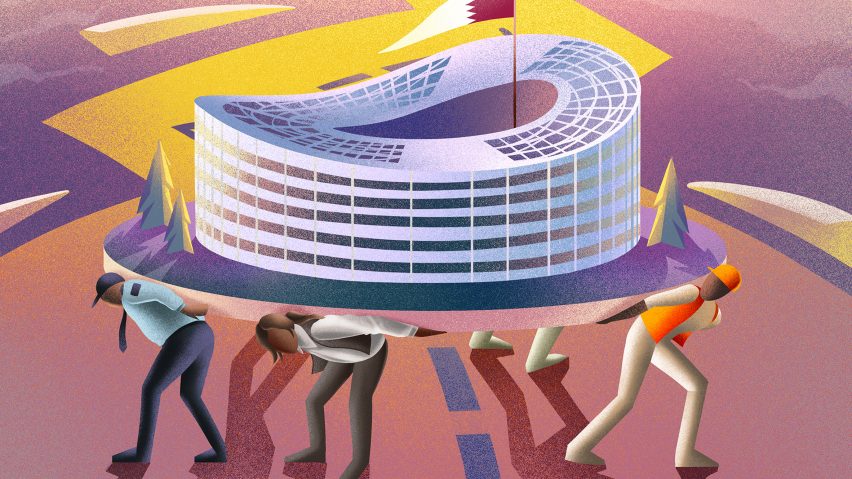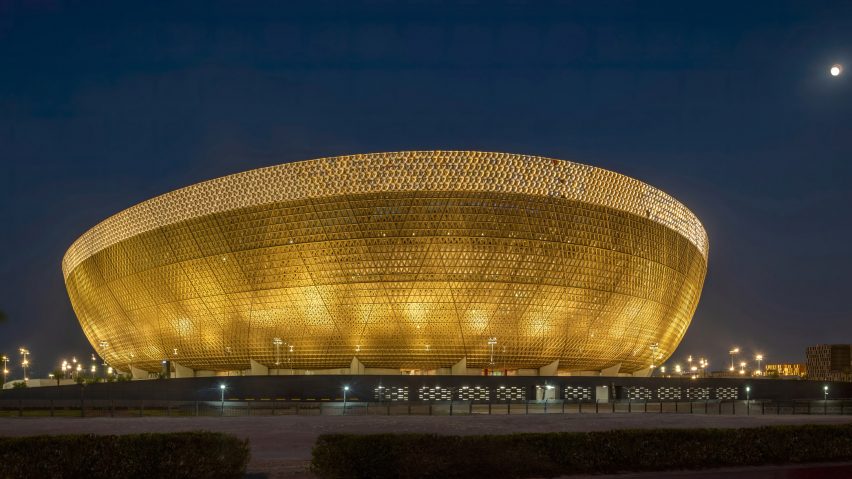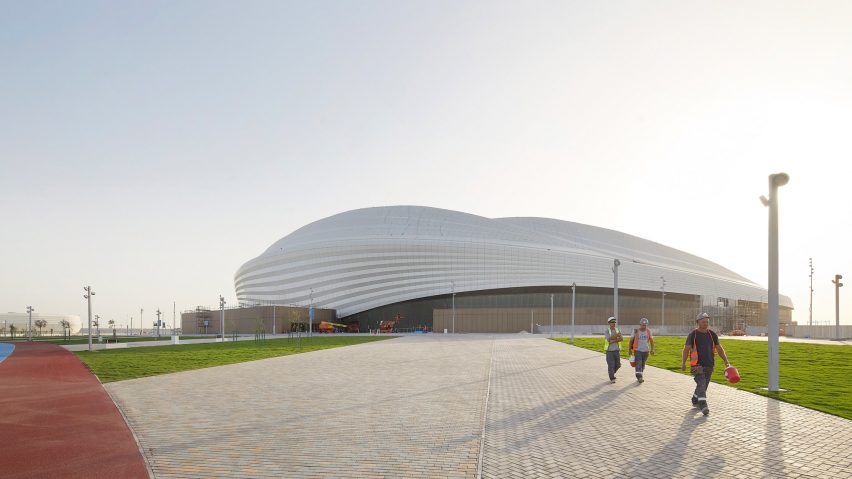
Silence of World Cup stadium architects "assists" Qatar's sportswashing attempts
Architects of the FIFA 2022 World Cup stadiums should speak out on human rights issues or risk helping Qatar in its "sportswashing attempts", says Amnesty International's Peter Frankental in this exclusive interview.
Speaking to Dezeen, economic affairs programme director at Amnesty International UK Frankental said the architecture studios that designed the stadiums for this year's World Cup, which include Zaha Hadid Architects and Foster + Partners, have a responsibility to use their position to call out human rights abuses.
"It's very important that [World Cup stadium architects] should be prepared to use their voice to draw attention to the human rights violations that are occurring," he said.

The 2022 World Cup in Qatar, which starts this week, will be hosted in eight stadiums built or refurbished for the event designed by architecture studios Foster + Partners, Fenwick-Iribarren Architects, Zaha Hadid Architects, Aecom, Dar Al-Handasah, Ibrahim M Jaidah, Ramboll and Pattern Design.
The stadiums have been largely built by migrant workers, with the country widely criticised for the conditions experienced by these workers including by Amnesty International, which accused Qatar of using forced labour on World Cup sites in 2016.
In 2021, the Guardian reported that 6,500 migrant workers had died in the county since 2010. According to football's governing body FIFA there have been 37 deaths connected to the construction of the World Cup stadiums.
"Silence does assist governments in their sportwashing attempts"
Amnesty International released a report last month stating that labour abuses are still happening "on a significant scale" in Qatar.
Frankental believes that if companies designing the event's stadiums do not make statements on these reported human rights issues they may be contributing to sportswashing – a term that describes the use of sports to distract from unethical practices.
"They can draw attention to human rights violations, which would give a lot of encouragement to human rights defenders and victims, rather than remain silent," he continued.
"So certainly, silence does assist governments in their sportwashing attempts, and holding human rights violations up to scrutiny does enable these governments to become more accountable for what they do."

However, Frankental believes that the architecture studios that designed the stadiums are not "directly contributing" to violations and may have little power to stop them occurring. The majority of the architecture studios involved in the design phases were not retained to oversee the buildings' construction.
"If an architect's firm was to design a reeducation centre in the Xinjiang province of China, then they can be said to be directly contributing to violations," he said, referring to the treatment of Uyghur Muslims.
"But with regard to the design of stadiums, they're not actually causing or contributing to violations, but they are linked to them via a business relationship with a Qatari government and therefore they have the responsibility to take whatever steps available to them – these can be contractual, technological, or otherwise – to avoid human rights violations linked to that business," he continued.
"The responsibility of companies is to do what they can within their spheres of influence, within their leverage. And it could be said that they have very little leverage over the Qatari government."
None of the architecture firms involved in designing stadiums for the tournament have issued public statements about the alleged human rights abuses that have been widely reported. In 2014 Zaha Hadid Architects founder Zaha Hadid said that preventing migrant deaths at her Qatar stadium was "not my duty as an architect".
Dezeen contacted the studios involved in designing the World Cup stadiums to ask how they had used their influence. Foster + Partners, which was the only studio to respond, explained that it had added clauses into its contracts but was not retained for the stadium's construction phase.
"We are committed to the welfare of construction workers on our projects across the world," said a spokesperson. "At Lusail Stadium, we made modifications and additions to the specifications in the preliminary tender documents to ensure that they adhered to stringent standards for workers' welfare," they continued.
"But in the event, we were not appointed for the construction phase and the workers' welfare programme was managed by others."
"Only a matter of time" before companies have to do due diligence
To ensure that architecture studios do not contribute to abuses, Frankental expressed the importance of carrying out human rights impact assessments before engaging on any project and withdrawing if abuses are likely to occur during the construction of a building.
"Companies should be aware of the impact of their activities and see what they can do to mitigate them," he said. "Obviously if serious human rights violations are going to arise directly because of their activities, then they have a responsibility not to invest in the first place."

According to Frankental "it's only a matter of time before companies will be required to do due diligence". He stated that carrying out human rights due diligence is already a requirement in France for certain large companies and that legislation is being planned in the EU.
He also drew attention to the fact that people have already sued UK companies for human rights abuses that have happened in other countries, including the wife of a man who died breaking up a ship in Bangaldesh that was sent to the yard by a British company.
"It would be very interesting if the family of any of the workers who died on the job were to sue to a firm of architects or any other company or construction firm involved in the project on the grounds that they should have known that there was a risk to all those working – whether that direct link as a company sending a ship to a shipbreaking yard? That's another question," Frankental.
"Architect firms might be one step removed, but nevertheless if there are things that they can do, then they need to."
"Contractual means can be used for the prevention of human rights violations"
Frankental acknowledged that architecture contracts could potentially hinder architecture studios' ability to comment on matters related to human rights abuses. However, he also highlighted that contracts could be used to avert them.
"Contractual means can be used for the prevention of human rights violations," he said. "For instance, pharmaceutical companies have tried to stop their products been used for administration of the death penalty in the US."
"If there are contractual ways in which a firm of architects can could limit, can prevent, human rights violations from taking place that is something they need to consider," he continued.
He added that the architecture profession should work collaboratively to reject clauses that restrict their ability to speak out.
"If they enter into contracts which stop them from speaking out on human rights issues, then maybe they should get together with other companies in their sector and try to prevent this," he argued. " It's also an issue of course, and freedom of expression."
Read on for the full interview with Frankental:
Tom Ravenscroft: Amnesty International has reported extensively on the exploitation of migrant workers building the World Cup stadiums – what level of responsibility do the architects that designed these stadiums have for the abuses that you've reported happening on the ground there?
Peter Frankental: All companies have a responsibility under international standards applicable to companies. And the most authoritative international standard is the UN Guiding Principles on Business and Human Rights that was adopted by the Human Rights Council in 2011. It's been endorsed by states, by trade unions, by business associations, and by civil society organisations.
The UN guiding principles set out very clearly what the responsibility of companies is in respect human rights. And that applies to companies across sectors large and small. And the most fundamental requirement is that companies must conduct human rights due diligence to ensure that they don't cause or contribute to human rights violations, but also that they take steps to mitigate impacts if they're linked to human rights violations through a business relationship.
And that is where architecture firms would come into play. Obviously, if an architect's firm was to design a reeducation centre in the Xinjiang province of China, then they can be said to be directly contributing to violations. But with regard to the design of stadiums, they're not actually causing or contributing to violations. But they are linked to a business relationship with a Qatari government. And therefore, they have the responsibility to take whatever steps available to them. These can be contractual, technological, or otherwise to avoid human rights violations linked to that business.
Tom Ravenscroft: The obvious question with Qatar, is have they achieved that?
Peter Frankental: Well, the responsibility of companies is to do what they can within their spheres of influence, within their leverage. And it could be said that they have very little leverage over the Qatari government.
They might have leverage, say over through their contracts with developers or construction companies, I don't know how these how architects structure their relationships, but they might have some influence over the labour used in the construction of the stadiums, but they might have no influence. Obviously, if they have no control, no influence, no leverage, there's not a lot that they can actually do.
Tom Ravenscroft: So you are saying in some way they're powerless to impact what happens on the ground?
Peter Frankental: They are, but in order to be able to establish that, they need to do comprehensive impact human rights impact assessments, they need to look at how any of their relationships might have impact on human rights. And, throughout the lifecycle of the project, and for them, the project is the use of their stadiums.
So if they decide that by entering into a relationship with the Qatari government to construct these stadiums that human rights violations will arrive, then they can't argue that they don't have the knowledge and foreseeability. And knowledge and foreseeability is an element in corporate complicity and can make companies under some circumstances legally liable. If companies know that there's a risk that their activities will contribute to human rights violations directly or indirectly, then they can be held accountable. And they've been cases in English courts, which have validated that. But not with architects.
Tom Ravenscroft: So if the responsibility is determined at the point they enter into this agreement? Studios like Zaha Hadid Architects and Foster + Partners have obviously made a decision to partner with the Qatari Government on this project...
Peter Frankental: They need to ask themselves these questions in advance. Human rights due diligence about they have to try to anticipate what is the impact of their decision to design an edifice? Obviously, their design will lead to its construction and its use and part of their lifecycle impact assessment has to foresee what the human rights risks are. And then to try to see what they can do to mitigate those risks. Are there practical solutions that architects can adopt to mitigate those impacts? I mean, I don't know the answer. But that's part of the due diligence process.
Tom Ravenscroft: So they have to predict likely issues?
Peter Frankental: Let me give you an example. A legal example. A UK company sent a ship to Bangladesh for destruction for a shipbreaking. And one of the workers involved in the shipyard died. And the family of the workers sued in the UK through the court here at the judge found that, given how appalling health and safety standards were in this particular shipyard in Bangladesh, there was every likelihood that some accident might befall workers breaking up that ship.
The fact that that same person might have been subjected to human rights violations because of the activities of some other party does not in any way diminish the responsibility that this company had because of the knowledge and foreseeability that they had.
Tom Ravenscroft: On the World Cup front then, given that you and others have reported multiple deaths on World Cup projects. Are the architecture studios potentially liable for that?
Peter Frankental: Well, there are parallels there. And it will be very interesting if the family of any of the workers who died on the job were to say to a firm of architects or any other company or construction firm involved in the project on the ground that they should have known that there was a risk to all those working, whether that direct link as a company sending a ship to a shipbreaking yard? That's another question, perhaps that's one step, you know, architects, firms might be one step removed.
But nevertheless, if there are things that they can do, then they need to, and they'll only be able to tell what it is that they might, if they do their due diligence properly, if they look at what the impact might arise from their business activities, and how those business impact might be mitigated and what role the architects firm might have in doing that.
Tom Ravenscroft: So are companies likely to be more at risk if they haven't done their due diligence beforehand?
Peter Frankental: Yes, I mean, it's the early days yet, because the requirement to do human rights due diligence isn't embodied in UK law at the moment. But there's a but due diligence is embodied in laws in some other countries.
For instance, in France it's called duty of vigilance – it applies to a small number of large companies. And there's an EU directive at the moment going through the commission and parliament, on human rights, due diligence. And also laws being developed in other countries, including the Netherlands and Germany. It's only a matter of time before companies will be required to do due diligence.
So for instance, now, under the Environment Act that was passed last year, companies are required to do due diligence to ensure that products arising from illegal forms of deforestation don't enter the UK market. So this concept of due diligence is increasingly being embedded in law, in policy and regulation.
And that means that companies, even if they're not liable now, further down the road might become liable. So they need to do their human rights due diligence.
Tom Ravenscroft: Is there an additional responsibility as stadiums are such a visible element of World Cup. Qatar has been accused of sportswashing. What level of complicity do you think the architects designing the stadiums that will appear on TVs in millions of households have in this sportswashing?
Peter Frankental: I don't think I can say that architecture firms will be complicit in Qatar's sportswashing, because after all, any state that has a major sporting event is going to try to showcase its achievements. Perhaps divert attention from some of the less savoury aspects of its policies and practices, and particularly human rights.
So if firms were not to have any role at all, and the activities in countries we chose major sporting events, on grounds of sportswashing, then, you know, they wouldn't be and we would be advocating a boycott of, of activities in so many countries. And when we don't do that, it's very difficult to know where to draw the line.
More to the point is the companies should be aware of the impact of their activities and see what they can do to mitigate and obviously, if serious human rights violations are going to arise directly because of their employment, then they have a responsibility not to invest in the first place, but not to pursue these activities.
But if it's through a business relationship with, say, a government, then the question is, what influence might they have through that relationship? One thing that all companies can do is make the point out human rights violations that are concerned about the football authorities, they've been, you know, uncritical of the Qatari government.
They haven't done enough to draw attention over the years, the human rights violations have been occurring there in the context of the World Cup, construction of infrastructure. That's something that any company can do. They can draw attention to human rights violations, which would give a lot of encouragement to human rights defenders and victims, rather than remain silent. So certainly silence does assist governments in their sportwashing attempts, and holding human rights violations up to scrutiny does enable these governments to become more accountable for what they do.
Tom Ravenscroft: So the companies that are involved in designing the World Cup there's a responsibility to use their voice to call out the human rights abuses.
Peter Frankental: Exactly, it's very important that they should be prepared to use their voice to draw attention to the human rights violations that are occurring. Obviously, that can muddy the waters for some of their business interests. So there's a balance that they need to strike.
Tom Ravenscroft: Also can contracts influence how much they can say?
Peter Frankental: Well, that is an issue. Contractual means can be used for the prevention of human rights violations. For instance, pharmaceutical companies have tried to stop their products been used for administration of the death penalty in the US. They use contractual means and have enforced these through the courts.
If there are contractual ways in which a firm of architects can could limit, can prevent, human rights violations from taking place, or third parties that they enter into contracts with whether they're states or companies. And that's something they need to consider.
Conversely, they enter into contracts, which stop them from speaking out on human rights issues, then maybe they should get together with other companies in their sector and try to prevent this. It's also an issue of freedom of expression.
The main image is courtesy of Amnesty International UK.